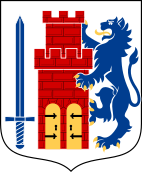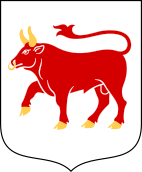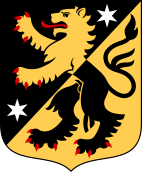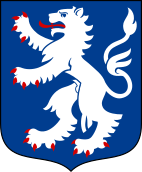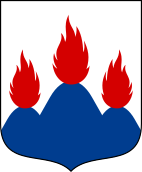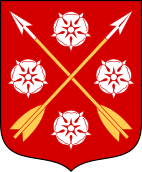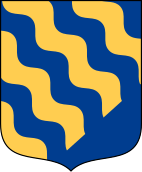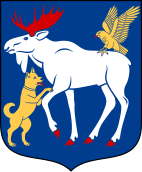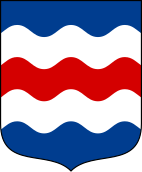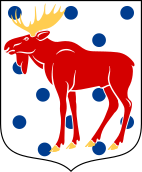Provinces of Sweden
This articleneeds additional citations forverification.(December 2007) |

The 25provinces ofSweden(Swedish:Sveriges landskap) arehistorical,geographical and cultural regions. They have no administrative function (except in some sports contexts), but retain their own cultural identities, dialects and folklore.
Several were administrative subdivisions until 1634, when they were replaced by thecounties of Sweden(län). Some were conquered later on fromDenmark–Norway.Others, like theprovinces of Finland,have been lost.
In some cases, the county and province borders correspond almost exactly, as withBlekingeandBlekinge County.The island ofGotlandis both aprovince,acountyand amunicipality(kommun). The only other province to share a name with a modern municipality isHärjedalen,though the borders are not quite the same. Administrative borders are subject to change – for example, several of today’s counties were created in the 1990s – while the provincial borders have remained stable for centuries. All the provinces are also ceremonialduchies,but as such have no administrative or political functions.
Nevertheless, the provinces of Sweden are no archaic concept; they are still referenced in everyday speech and seen as culturally distinct. The main exception isLapland,where people see themselves as citizens ofVästerbottenorNorrbotten,based on thecounties.
Sweden’s two largest cities,StockholmandGothenburg,both have provincial borders running through them: Stockholm is split betweenUpplandandSödermanland,and Gothenburg is split betweenVästergötlandandBohuslän.According to a 2011 survey, people in major cities – Stockholm, Gothenburg and, to a lesser extent,Malmö– identify primarily with their city, rather than their province.[2]
Provinces
[edit]| Swedish | Latin |
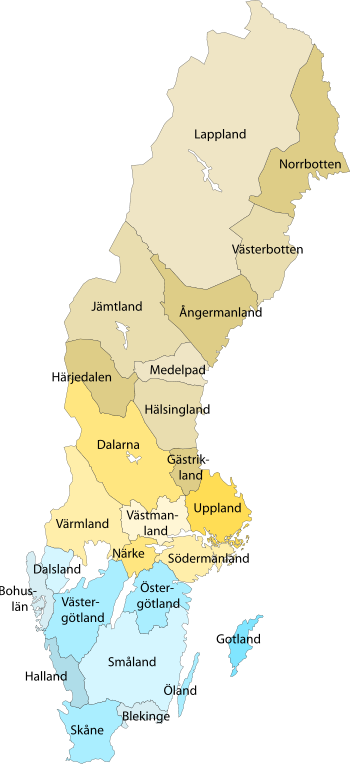 |
|---|---|---|
| Ångermanland | Angermannia | |
| Blekinge | Blechingia | |
| Bohuslän | Bahusia | |
| Dalarna | Dalecarlia | |
| Dalsland | Dalia | |
| Gästrikland | Gestricia | |
| Gotland | Gotlandia | |
| Halland | Hallandia | |
| Hälsingland | Helsingia | |
| Härjedalen | Herdalia | |
| Jämtland | Jemtia | |
| Lappland | Lapponia Suecana | |
| Medelpad | Medelpadia | |
| Närke | Nericia | |
| Norrbotten | Norbothnia | |
| Öland | Olandia | |
| Östergötland | Ostrogothia | |
| Skåne | Scania | |
| Småland | Smolandia | |
| Södermanland | Sudermannia | |
| Uppland | Uplandia | |
| Värmland | Wermlandia | |
| Västerbotten | Westrobothnia | |
| Västergötland | Westrogothia | |
| Västmanland | Westmannia |
[clarification needed]English and other languages occasionally use Latin names for the Swedish provinces. The nameScaniafor Skåne predominates in English. Some Englishexonyms,such asthe Dalesfor Dalarna,East Gothlandfor Östergötland,Swedish Laplandfor Lappland andWest Bothniafor Västerbotten are common in English literature.[3][4][5]Swedes writing in English have long used the Swedish names only.[6][7]
History
[edit]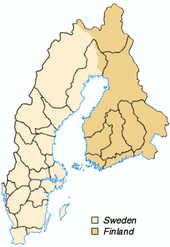
The origins of the provincial divisions lay in thepetty kingdomsthat gradually became more and more subjected to thecentral monarchyduring theconsolidation of Sweden.[8]Until the country law ofMagnus Erikssonin 1350, each of these lands still had its own laws and its own assembly (thething), and in effect governed itself. The first provinces were consideredduchies,but newly conquered provinces received the status of duchy orcounty,depending on importance.
After the separation from theKalmar Unionin 1523, the Kingdom incorporated only some of its new conquests as provinces. The most permanent acquisitions stemmed from theTreaty of Roskildein 1658, in which the formerDanishScanian lands(Skåne,Blekinge,HallandandGotland), along with the NorwegianBohuslän,JämtlandandHärjedalen,became Swedish and gradually integrated. Other foreign territories were ruled asSwedish Dominionsunder the Swedish monarch, in some cases for centuries. (Norway,inpersonal unionwith Sweden from 1814 to 1905, never became an integral part of Sweden.)
When Sweden ceded Finland to theRussian Empirein 1809,Västerbottenwas divided up so thatNorrbottenfirst emerged as a county. Eventually, it came to be recognized as its own province. It was granted a coat of arms as late as in 1995.[9]
Some scholars suggest that Sweden revived the concept of provinces in the 19th century.[10]
The lands of Sweden
[edit]Historically, Sweden was seen as containing four” lands” (larger regions):
- Götaland(southern Sweden)
- Svealand(central Sweden)
- Österland(Finland, from the 13th century to 1809)
- Norrland(northern parts of present-day Sweden and north-western Finland)
In theViking Ageand earlier, Götaland and Svealand were home to a number ofpetty kingdomsthat were more or less independent; Götaland in the Iron Age and Middle Ages did not includeScaniaand other provinces in the far south, which were then part ofDenmark.The leading tribe of Götaland in the Iron Age was theGeats;the main tribe of Svealand, according toTacitusca 100 AD, was theSuiones(or the” historical Swedes” ).” Norrland” was all the unexplored northern parts, the boundaries and Swedish control over which were weakly defined into the early modern age.
Due to theNorthern CrusadesagainstFinns,TavastiansandKareliansandcolonisation of some coastal areasof the country, Finland fell under the Catholic Church and Swedish rule.Österland( "Eastern land"; the name had early gone out of use) in southern and central Finland formed an integral part of Sweden. Russia annexed Finland in 1809, and reunited it with some frontier counties annexed earlier to form theGrand Duchy of Finland.In 1917, Finland becamean independent country.
The regional borders have changed several times throughout history with changing national borders. Norrland, Svealand and Götaland are onlypartsof Sweden, and have never superseded the concept of the provinces.
Heraldry
[edit]At the funeral of KingGustav Vasa(Gustav I) in 1560, arms for 23 of the provinces were displayed together for the first time, most of them created for that occasion.[11][9]Erik XIV of Swedenmodelled the funeral processions on those of Germandukes,who in turn may have styled their displays afterEmperor Charles V's funeral, where a host of banners represented each entry in the King’s long list of titles. Gustav Vasa’s title only had three entries – "King ofSweden,the Gothsandthe Wends"– so banners were created for each Swedish province for a better display.
Some of these arms were short-lived, such as the beaver forMedelpad(changed in the 1570s)[9],the wolverine forVärmland(changed in 1567)[9]and the roses onSmåland’s arms.Östergötlandwas represented by two different arms, one with aVästanstångdragon and one with aÖstanstånglion. The current arms for Östergötland (see below) were created in 1884.[9]
The current arms for Småland were created for the coronation ofJohn IIIin 1569. The wild man representingLapplandwas created for the funeral ofCharles IXin 1612[9].Arms for Jämtland were created when Norway ceded the province to Sweden in 1635. Arms for Härjedalen were created later. The arms for Blekinge, Bohuslän, Halland and Skåne were created for the funeral ofCharles X Gustavin 1660. The Arms for Norrbotten were created as late as 1995.[9]
Götaland
[edit]Götaland(Gothia,Gothenland) comrpises ten provinces in the southern part of Sweden. Until 1645,GotlandandHallandwere parts of Denmark. Also, until 1658BlekingeandScaniawere parts of Denmark, andBohuslänwas part ofNorway.Värmlandwas counted as part of Götaland until 1812.
Svealand
[edit]Svealand(Swealand) comprises six provinces in central Sweden. Until 1812, Värmland was counted as part of Götaland instead.
Norrland
[edit]Norrland(Northland) today comprises nine provinces in Northern and central Sweden. Until 1645 the provinces ofJämtlandandHärjedalenwere parts of Norway. In 1809, when Sweden ceded Finland to theRussian Empire,the old province ofLaplandwas split intoSwedish LaplandandFinnish Lapland.Norrbottenwas separated fromVästerbottenat the same time, and developed its own provincial identity during the 19th century.
See also
[edit]References
[edit]- ^"Folkmängd i landskapen den 31 december 2016"(in Swedish).Statistics Sweden.21 March 2017.Archivedfrom the original on 31 October 2022.Retrieved17 April2018.
- ^GfK Sverige AB (21 December 2011)."Svenskarna är mer lokala än nationella i sin geografiska identitet".Archivedfrom the original on 13 December 2021.Retrieved13 December2021.
- ^Eric LinklaterinThe Life of Charles XII
- ^Robert Nisbet BaininGustavus III and His Contemporaries
- ^Bernard QuaritchinThe stories of the Kings of Norway Called the Round World (Heimskringla)
- ^R. Svanström & C.F. Palmstierna inA History of Sweden(1934)
- ^Nils AhnlundinGustav Adolf the Great(1940)
- ^Clemensson, Per; Andersson, Kjell (2004).Your Swedish roots: a step by step handbook.Provo, UT: Ancestry. p. 30.ISBN978-1-59331-276-3.
- ^abcdefgNevéus, Clara (1992).Ny svensk vapenbok(in Swedish). Stockholm: Streiffert i samarbete med Riksarkivet.ISBN978-91-7886-092-0.
- ^Jacobsson, Benny (2000)."Konstruktion av landskap. Exemplet Uppland"Archived2 February 2009 at theWayback Machine.Idéhistoriska perspektiv.Ed. Ingemar Nilsson, Arachne 16, Göteborg 2000, p. 109-119. Retrieved 20 October 2006. (In Swedish).
- ^von Konow, Jan (1993)."Landskapsvapen"[Regional arms].Nationalencyklopedin(in Swedish). Vol. 10. NE Natnionalencyklopedin.ISBN978-91-976240-9-1.

